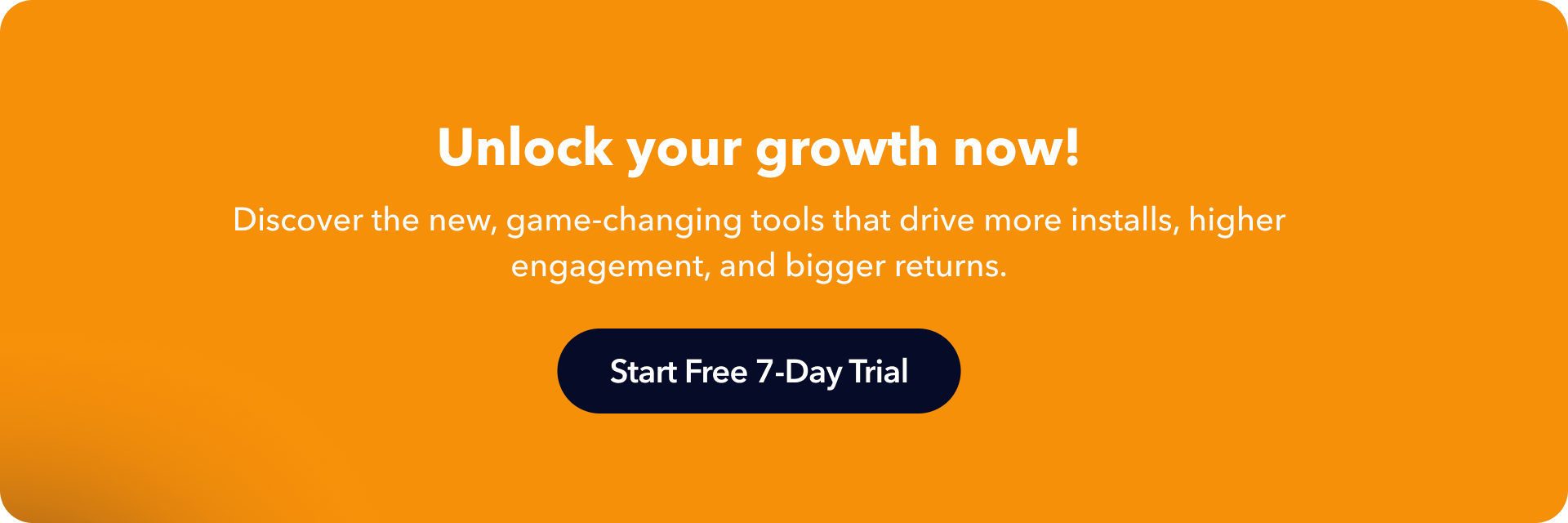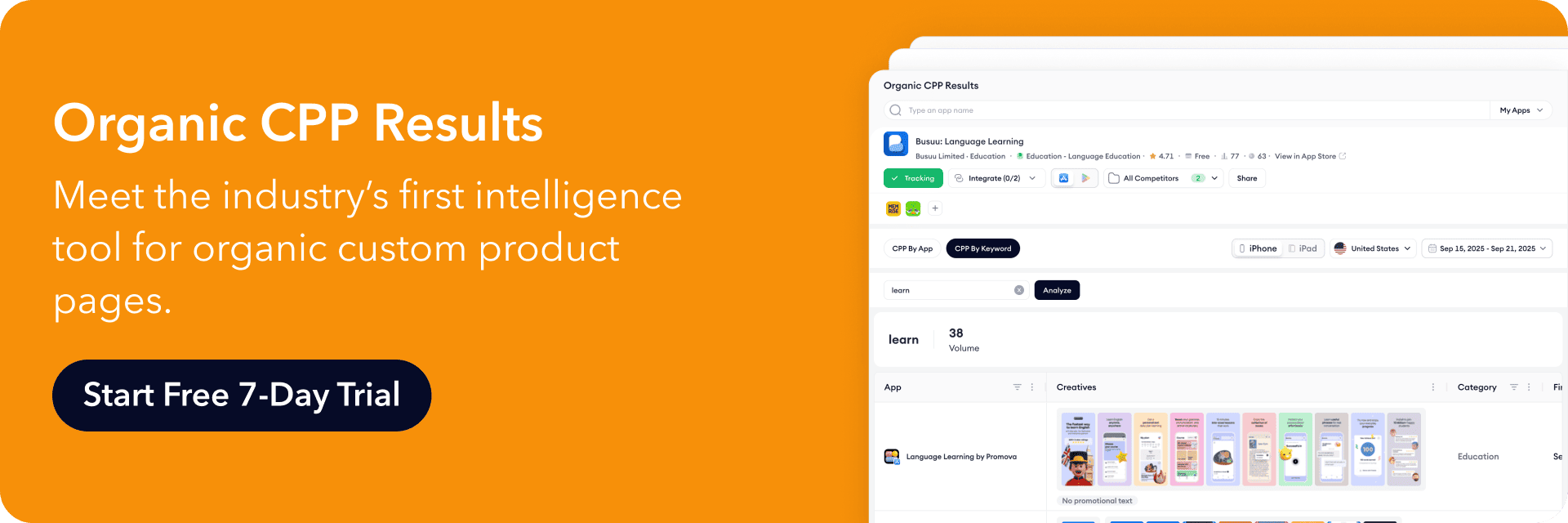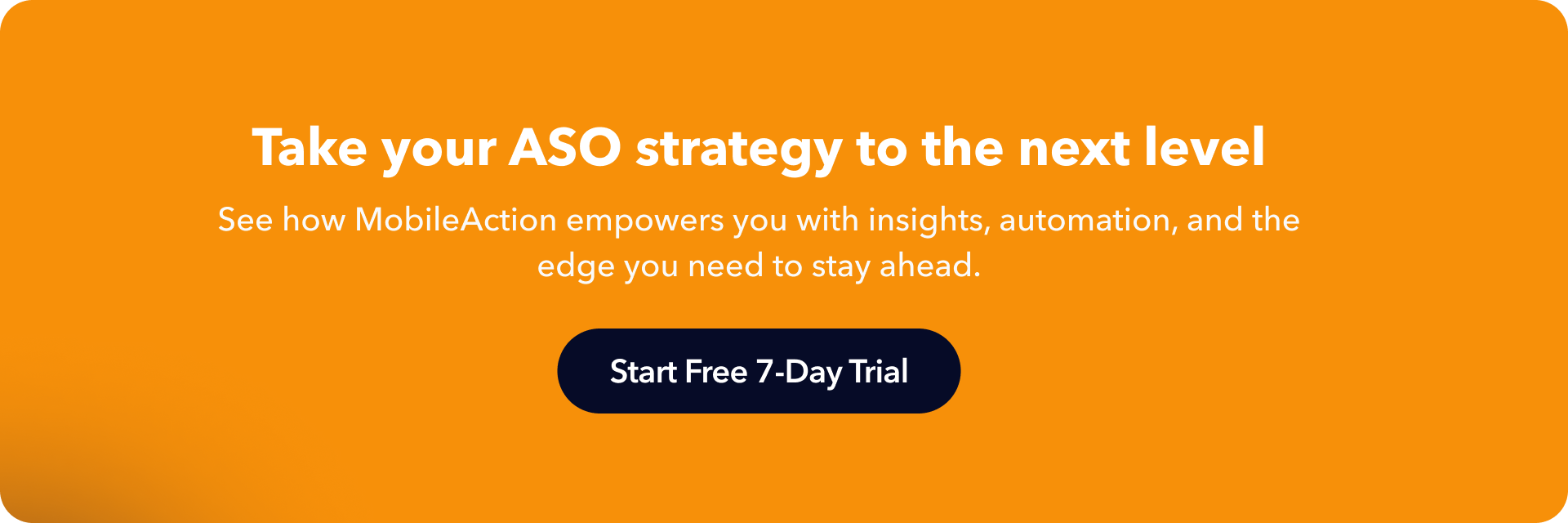Looking to boost your app's visibility and acquire more users? Our 2025 ASO Report is your ultimate guide to navigating the evolving app store landscape. Packed with data-driven insights, keyword trends, and top-ranking app strategies, this report will equip you with the knowledge to optimize your app's presence and achieve organic growth.
App store algorithms have evolved. In 2025, Apple and Google will reward apps that meet all of these criteria: relevance, conversion, and quality. That means great visuals, positive reviews, and smooth performance are as important as your metadata strategy.
To stand out, you need to think like both the algorithm and the user. Visibility might get you noticed, but it’s trust and experience that turn curiosity into installs.
In this blog, we’ll break down how to boost app downloads, grow organic visibility, and build the App Store presence that continues to drive installs long after your launch day.
Key Takeaways
- Conversion drives growth. Apple and Google reward product pages with better tap-to-install rates.
- Quality sustains visibility. Retention, crash rate, and refund rate are ranking signals in 2025.
- Trust signals matter. Ratings, reviews, retention, and technical performance all influence algorithmic visibility.
- Localization makes you relatable. Metadata, keywords, and visuals should reflect how users search and engage in each market.
- In-app events and promotional content boost visibility. Event cards and featured updates showcase apps to new and returning users.
- ASO is never “done.” Top-performing apps continuously test, optimize, and evolve.
What drives the App Store visibility in 2025
In 2025, how to boost app downloads depends on three things: relevance, conversion, and quality.
Your app must first be relevant to user searches. Use clear titles, subtitles, and keywords that help the App Store understand your app and match it with the right queries.
Once users find it, conversion determines whether they download it. Strong visuals, clear descriptions, and positive ratings make your app more appealing and trustworthy.
Finally, quality keeps your app visible. Apps that perform smoothly, deliver real value, and maintain high retention are rewarded with better rankings.
iOS vs Android ranking factors
| Signal | iOS (App Store) | Android (Google Play) |
| Metadata weight | Title, Subtitle, Keyword field | App Name, Short Description, Full Description |
| Visual impact | Icon, first 3 screenshots, App Preview video | Icon, Feature Graphic, first 3 screenshots, Promo video |
| Behavioral signals | Installs; ratings & reviews. (Track product page conversion rate in App Store Connect to improve these.) –Apple Developer | Installs; ratings & reviews, Android Vitals measure technical quality, excessive crash or ANR rates can reduce discoverability. –Google Help |
| Trust | Ratings, reviews, sentiment,and in-app purchase refund rate | Ratings, reviews, Android Vitals |
| Localization levers | Up to 35 custom product pages with keyword targeting | Up to 50 custom store listings with keyword modifiers |
👀 Curious about how these signals work behind the scenes? You can learn more in our detailed post on the App Store ranking factors and visibility in 2025.
✴️ Tip: Apple’s 2025 update allows each custom product page to replace your default page in organic search for assigned keywords. This means you can link different pages to different search terms, giving users a version of your page that best matches what they’re looking for.
7 ways to boost app downloads in 2025
We’ve already discussed what drives visibility: relevance, conversion, and quality. Now it’s time to explore how to boost app downloads in practice. The seven strategies below turn those principles into action, helping your app get discovered, build trust, and convert more users across every market.
1. Optimize your first impression: Visuals that convert
Understanding how to boost app downloads starts with user intent. People install apps that feel instantly relevant to what they’re searching for or need at that moment. When your product page clearly communicates value through focused visuals and messaging, you build trust before the tap. Every element, from screenshots to copy, shapes that first impression and influences conversion.
-
Design an app icon that grabs attention
Your app icon can shape how users perceive your app before they even read your name. It influences your tap-through rate and visibility. Focus on creating an icon that instantly communicates your app’s purpose and feels native to the latest design language, like Apple’s new Liquid Glass style. When your icon looks current, relevant, and aligned with user intent, more people tap in, and that small behaviour signal can make a big difference in your rankings.
Best practices:
- Stick to one bold symbol or character, and avoid text unless it’s globally recognized.
- Use vivid contrast to stand out against common background colours.
- Test rounded vs. square elements depending on platform (iOS has mask overlays).
- Avoid clutter, prioritize recognizability over detail.
MobileAction’s Creative Monitoring feature lets you analyze top competitors’ icons, helping you detect emerging trends and avoid dated visuals.
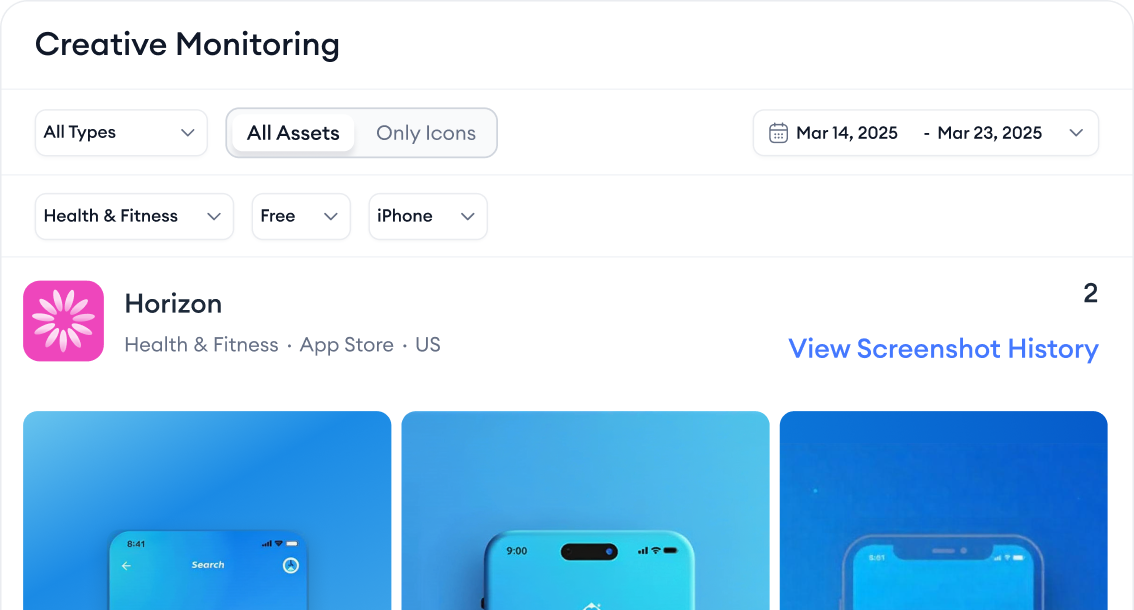
-
Use highly relevant screenshots and videos
Your first 3 screenshots are crucial; they appear in search results, especially on iOS. Their job is to explain the core value of your app at a glance.
What to do:
- Show the core user journey in sequence, e.g., search > pick > result.
- Add clear, localized copy at the top to highlight benefits (“Get deals in 3 taps”).
- Align each screen’s background colour for visual continuity.
- Use video thoughtfully. A short 15–30-second preview that shows real interaction or gameplay can be more effective than static screenshots.
✴️ Tip: In 2025, Apple’s Product Page Optimization (PPO) lets you A/B test creatives directly in App Store Connect. Google’s store listing experiments offer the same for Android. You can take a look at how to use App Store Connect in 2025.
-
Show the right store listing for each search (iOS custom product pages & Google Play CSL)
In both app stores, you now have the power to assign specific product pages to specific audiences.
- Custom product pages on iOS let you build up to 35 variants with tailored visuals, copy, and deep links. You can map them to paid campaigns or organic keywords.
- Custom store listings on Google Play offer up to 50 variants, each localizable by language, region, and now, keyword intent.
Here’s what that unlocks:
- Show “fitness-tracking” visuals to users searching for “health apps”
- Show “meal planning” features to those searching for “calorie tracker”
- Tie your icon + screenshots + subtitle together for each variant to maximize TTR
For iOS apps, MobileAction’s Organic CPP Results show which keywords trigger your custom product pages, what visuals competitors display for each term, and where your assets may not align with user intent.
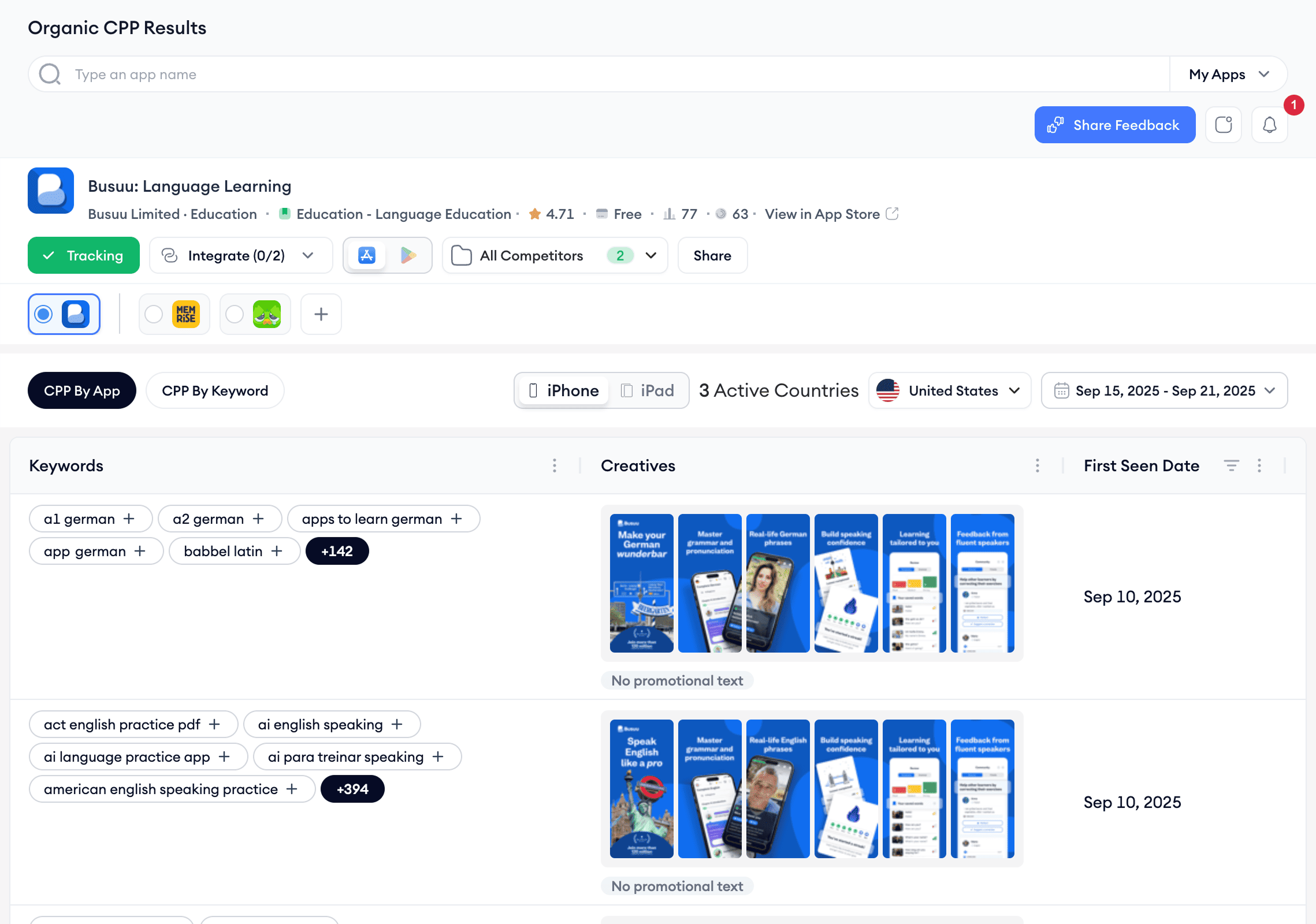
2. Grow your downloads with stronger ASO fundamentals
Understanding how to boost app downloads starts with solid ASO fundamentals. App Store Optimization focuses on three main factors: search intent, metadata quality, and how relevant your store page is to each query. When these work together, your app becomes easier to find and more convincing to install.
-
Conduct keyword research with intent
Strong ASO keyword research is the core of how to boost app downloads. Instead of chasing high-volume terms like “fitness,” focus on queries that reveal what users actually want, such as “home workout tracker” or “HIIT timer.”
Sort by intent. Think of each query as a moment:
- Generic (“meditation app”): iOS: default product page • Android: main store listing
- Problem → solution (“sleep better app”): iOS: Custom product pages for sleep • Android: CSL for sleep
- Feature (“breathwork app”, “mindfulness reminder”): iOS: Custom product page for feature • Android: CSL for feature
- Persona (“study focus app for students”): iOS: Custom product page for students • Android: CSL for students
- Competitor/alternatives (“[brand name] alternative”): iOS: Custom product page for comparison • Android: CSL for comparison
- Branded (“[brand name] sleep stories”): iOS: Default product page or custom product page for brand+feature • Android: Main store listing or CSL for brand+feature
MobileAction helps you uncover these opportunities through its features like Keyword Inspector and Keyword Trends. You can compare search volumes, analyze difficulty levels, and spot rising terms before competitors do.
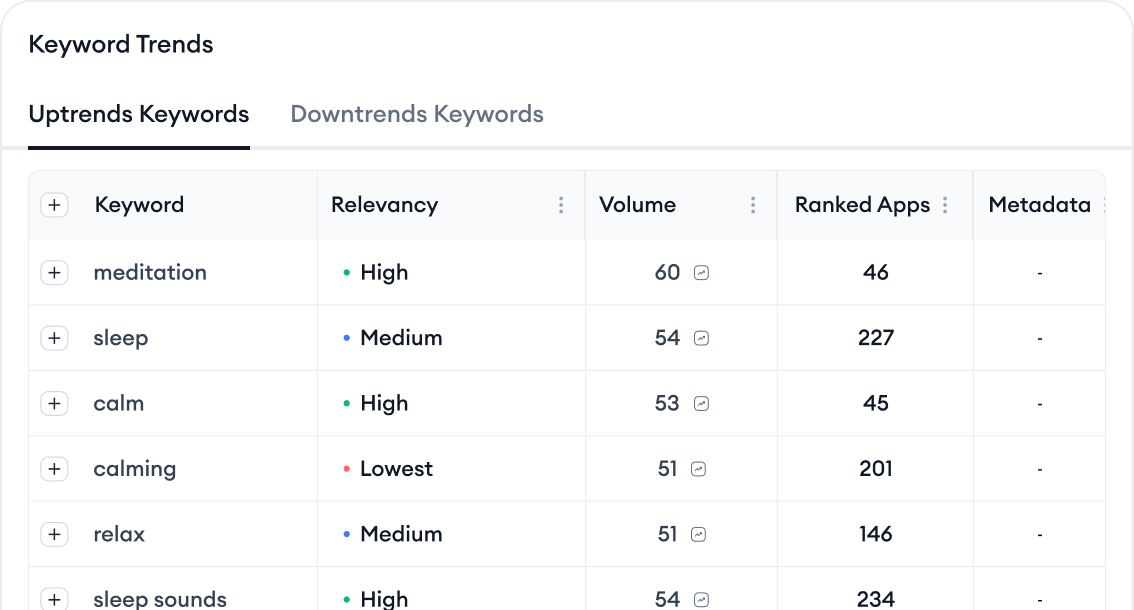
-
Optimize metadata and descriptions
Your title, subtitle, and description tell both the algorithm and the user what your app does. Well-structured metadata increases discoverability, while clear descriptions improve conversions.
|
Field |
Best length (2025) |
What matters most |
Common pitfalls |
|
App Name / Title |
≤30 chars (iOS) / ≤30 chars (Play) |
Primary keyword + brand |
Stuffing duplicate terms |
|
Subtitle / Short Desc |
30 chars (iOS) / 80 chars (Play) |
Secondary benefit keyword |
Promotional pricing, emoji spam |
|
Keyword field (iOS only) |
100 chars |
Long-tail & misspellings |
Brand names, competitor trademarks |
|
Full Description (Play) |
4,000 chars |
Semantic entities, feature list, CTA links |
Repeating keywords, URL stuffing |
MobileAction’s Metadata Optimizer predicts how your metadata changes might impact visibility, while the ASO Report help you compare your performance and identify areas where competitors gain traffic.
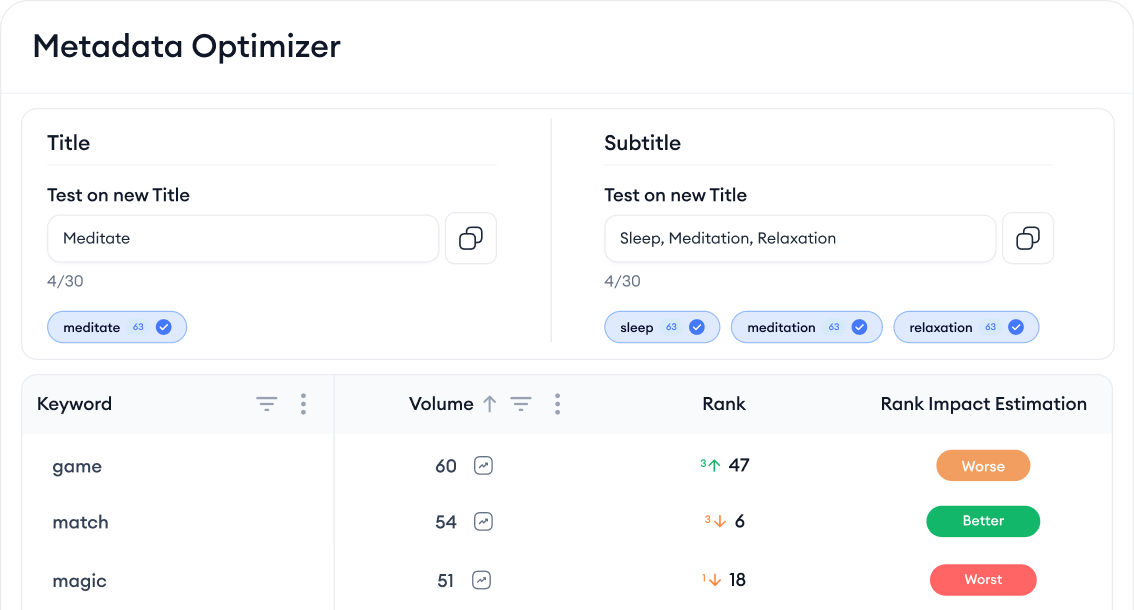
-
Map keywords to the best store listing (custom product pages on iOS, CSL on Android)
Apple now lets you assign up to 35 custom product pages to organic search terms, meaning each keyword can trigger a bespoke combination of screenshots, video, and messaging. This level of control helps you show users exactly what they’re searching for, and that precision is a big part of how to boost app downloads today.
✴️ To explore how this feature can reshape your ASO strategy, read: Custom product pages meet organic search.
Google Play also supports up to 50 custom store listings that let you display tailored visuals and messaging based on users’ search keywords.
For example, a meditation app can show “sleep” visuals for users searching “sleep better,” and “stress relief” visuals for “calm anxiety.”
MobileAction’s Organic CPP Results feature lets you see how custom product pages appear in organic search and which keywords trigger them. You can analyze what type of pages your competitors use and apply the same strategy to match user intent across different segments or geographies.
3. Build trust and social proof
Let’s say your app is easy to find and people are downloading it. Sounds great, right? But that’s not the whole story. To keep growing, you need people to trust your app.
Think like a user, when we download an app, we’re giving it our time, data, and sometimes money. Before downloading, we always check what other users say. It shows us that the app is safe, reliable, and really works the way it promises.
-
Ask for reviews at the right moments
RequestReviewAction is Apple’s tool that lets you ask users to rate or review your app without leaving it. Instead of opening on the App Store, users see a small pop-up inside your app where they can tap stars ad leave a short review.
✅ Example: If someone just finished a game level or completed a goal, you can trigger RequestReviewAction to show a short message like:
“Enjoying the app? Please take a moment to rate us!”
This makes it quick and easy for users to give feedback right when they’re happy, which usually leads to more positive reviews.
-
Monitor your reviews and respond to user complaints
Your reviews shape how people see your app and how the store ranks it. ASO experts agree that average rating, review volume, and responsiveness directly affect both visibility and installs. As announced at WWDC 2025, AI-generated review summaries now make your replies more visible to potential users.
If you want to understand how to boost app downloads over time, maintaining a healthy review profile is essential. Check new reviews daily, respond quickly, stay polite, and provide a clear next step such as a fix, a workaround, or a planned update. When an issue is resolved, update your reply, many users notice this and change their rating to positive.
To make this process easier, MobileAction lets you manage everything in one place. You can set up alerts, filter reviews by rating or keyword, track trends with Most Mentioned Keywords, and reply faster using AI Review Reply connected to your store account.

-
Leverage influencer and user-generated content
Flat download charts are frustrating, especially when you know people love the app after trying it. The fastest way to close this gap is to get real people (creators and everyday users) to tell your story and then place their voices directly where new users are already searching.
Authentic voices lower ad costs and increase organic visibility at the same time. Influencer-shot or user-shot videos can cut your cost-per-acquisition by 30% versus brand-made ads, according to Aspire’s influencer report.
- Match pains to pages, build a custom product page or custom store listing for each key pain (“sleep better,” “budget fast”) and tie in matching keywords.
- Film 30-sec demos, give micro-influencers a “hook, demo, try-it” script; let them use their own style.
- Amplify top creator posts via TikTok Spark Ads or Instagram Partnership Ads to keep social proof intact.
- Track every click: Share custom product pages and CSL URLs with campaign tokens or Install-Referrer UTMs so you know which post moved installs.
- Spark in-app challenges: Reward users for posting screenshots or short reels with a branded hashtag.
4. Use viral loops and user referrals for customer acquisition
One of the most reliable answers to how to boost app downloads is to turn user satisfaction into momentum. Viral loops and referrals grow trust faster than paid ads because people believe real users more than ads. Encourage sharing right after value moments, when a user finishes a workout, completes a level, or hits a streak.
Offer double-sided rewards like credits or bonus access to keep both sides engaged. Track referral installs and retention over time to refine what works.
-
Create shareable in-app moments and social media content
People share moments that make them feel proud, surprised, or rewarded, and social media amplifies that effect. By designing both your product and your content strategy for shareability, you can turn users into advocates and reach new audiences organically.
But shareability doesn’t end in your app. Build an external presence that reinforces your brand story across channels:
- Add quick-share buttons for achievements, scores, or completed goals.
- Use short-form videos (Reels, TikToks, YouTube Shorts) to showcase real app moments; e.g., “before/after” results, challenges, or user testimonials.
- Run community-driven challenges (like a 7-day streak or user-generated hashtag) to spark user participation and social proof.
- Invest smartly in paid social. Run lightweight, targeted campaigns on Meta, TikTok, or Reddit to boost visibility for your top-performing creatives. Pair each ad or post with a custom product page or CSL so you can track installs precisely.
-
Build gamified referral programs and incentives
Referrals remain one of the most effective and low-cost acquisition channels. Gamify the experience, reward both the sender and receiver, and make participation frictionless.
- Offer extra features, credits, or in-app currency for referrals.
- Add visual progress indicators (“Invite 3 friends to unlock premium”).
- Keep messages short, clear, and shareable across platforms.
-
Use in-app events (iOS) & promotional content (Android) to re-engage users
Apple’s In-App Events (IAE) and Google Play’s promotional content surface timely promotions on the store home page, even to lapsed users. Think of them as free billboards you can refresh weekly.
- Plan a calendar. Seasonal challenges, limited-time skins, or co-brand drops all qualify.
- Craft event graphics. Keep titles under 30 characters and use bright imagery that mirrors your in-app artwork.
- Localize by region. A Diwali event in India, a Golden Week sale in Japan, match cultural moments to boost click-through.
With MobileAction’s Category Events and In-App Events insights, you can analyze how each campaign affects rankings and conversions, giving you a clear view of how to boost app downloads.

5. Combine ASO and SEO to expand your reach
Organic ranking signals don’t live only inside the store. When people search the web for “best meditation apps,” or watch a creator’s listicle on YouTube, those off-store touchpoints drive branded searches and boost your keyword relevance, something both Apple and Google factor into visibility.
-
Grow brand visibility with educational content
Modern discovery starts with curiosity. When users search “how to sleep better” or “best budgeting apps,” your goal is to show up with value first, not just a download link.
- Own the question keywords. Create blog posts, YouTube videos, or LinkedIn carousels that genuinely help users (“How to improve focus” – feature your productivity app naturally).
- Turn data into stories. Share anonymized insights from your user base, for example, “Users who track sleep improved their rest by 17%.” These stats make your content shareable and press-worthy.
- Use structured data. Add the FAQ or HowTo schema to your web content so it appears in Google’s AI Overviews and rich results, sending qualified traffic straight to your store listing.
-
Launch omnichannel campaigns tied to store updates/events
Your campaigns work best when every touchpoint, from ads to the App Store visuals, tells one clear story. If you are planning how to boost app downloads around a feature release, connect the campaign to your store updates and events so users see the same message wherever they look.
- Synchronize creatives. Update icons, screenshots, and videos to match your campaign’s theme. If your social posts highlight “New Sleep Sounds,” your first screenshot should, too.
- Build anticipation. Launch teaser pages and waitlists for new features. When you go live, align your In-App Event (IAE) or promotional content visuals with your social creatives.
- Re-engage users consistently. Use email, push notifications, or remarketing ads to bring lapsed users back to your new campaign, using the same visuals and messages across all channels.
-
Collaborate with partners and complementary apps
Partnerships can expand your reach faster than ads. Co-marketing with other apps that share your audience creates win-win visibility.
- Bundle perks. Offer joint promotions, for instance, a fitness app can partner with a nutrition tracker for a shared premium trial.
- Co-create content. Host webinars, reels, or blog features that showcase both products. You’ll tap into new audiences with similar interests.
- Track cross-promotion results. Monitor keyword performance after the campaign using MobileAction’s Download Share.
6. Localize to maximize global visibility
Localization expands your reach across markets. By adapting your metadata, creatives, and messaging for each region, you increase your app’s relevance to local audiences. This higher relevance helps you surface in more country-specific search results, engage users in their own context, and boost conversion rates through cultural and linguistic alignment.
-
Adapt keywords, creatives, and messaging per locale
Every market searches differently. For example, while U.S. users might search “budget planner,” German users may look for “Haushaltsbuch.” Simply reusing English metadata won’t capture that demand.
- Localize your keywords. Research search behaviour in each region instead of translating directly.
- Adapt visuals and tone. Choose colours, symbols, and phrasing that resonate culturally. A celebratory hand gesture or symbol in one country may not carry the same meaning in another.
- Review local trends. Monitor app categories in different regions to spot seasonal or cultural shifts in user intent.
MobileAction’s Keyword Translator and Localization features make this easier by helping you identify relevant local keywords and compare textual localization across countries.
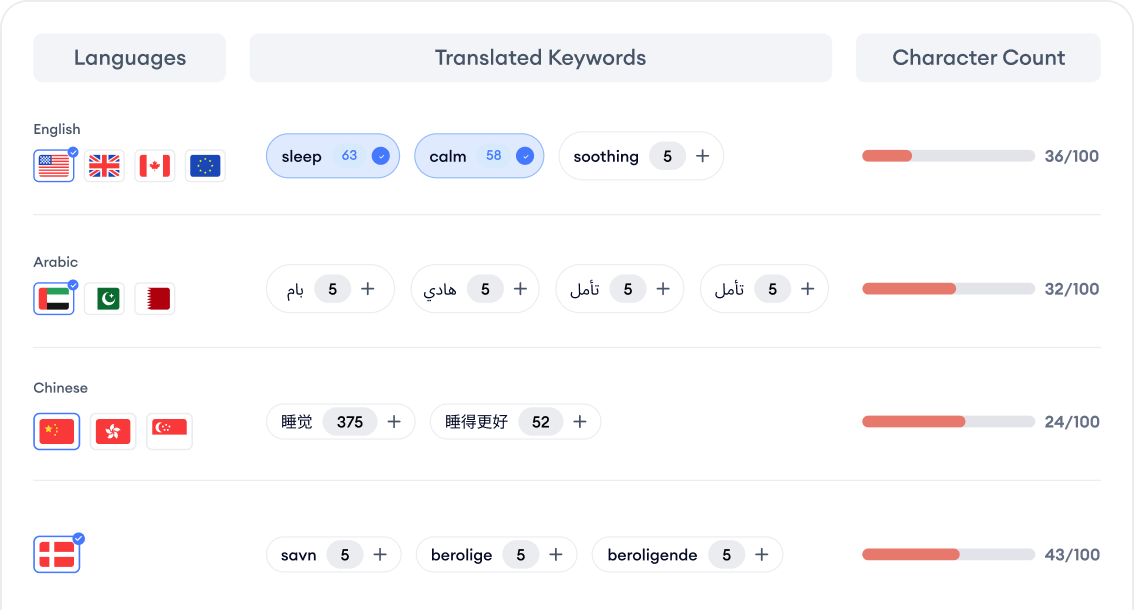
-
Localize and scale with regional custom product pages/CSLs
A proven tactic for how to boost app downloads in new markets is to localize your store presence. Create custom product pages on iOS and custom store listings on Android so each region sees content that matches its search intent.
- Assign local-language keywords to custom product pages so your pages appear for regional queries.
- Adjust creatives. Screenshots, taglines, and even currency icons, to match local context.
- On Google Play, use keyword-targeted CSLs to surface your localized listings for different countries and languages.
MobileAction’s Organic CPP Results and Visibility Reports show how these localized variants perform, letting you measure rank changes, conversion rates, and traffic shifts by country.
7. Track, analyze, and iterate
App growth is an ongoing process. Algorithms change, user behaviour evolves, and competitors adjust their strategies. To stay ahead, you need a system that measures what’s working, identifies what’s not, and helps you adapt fast.
-
Attribute organic uplift accurately
When downloads increase, it’s important to know why. Was it a successful keyword update, a strong in-app event, or external PR coverage?
- Use store integrations (App Store Connect, Google Play Console) to align traffic sources with real results.
- Track how organic installs change after running campaigns or publishing content.
- Compare performance across countries and platforms to identify your strongest growth levers.
-
Optimize pricing and monetization models
Monetization affects both retention and visibility. Apps that users keep and pay for tend to rank higher due to stronger engagement signals.
- Test different pricing tiers or subscription models to see what maximizes user satisfaction and lifetime value.
- Adjust store creatives to highlight new offers or free trials.
- Watch refund rates and user sentiment to ensure changes don’t harm trust.
You can monitor revenue and conversion shifts with MobileAction’s Revenue Snapshot and Analytics Overview, ensuring your pricing strategy aligns with sustainable growth.
ASO mistakes that limit your visibility
Let’s break down the top ASO mistakes and what to do instead to protect your rankings.
1. Treating ASO as a one-time task
Many developers update their metadata once, then move on. But the App Store algorithms evolve constantly, and user behaviour shifts just as fast. Keywords that worked three months ago may no longer convert. You have to treat ASO like SEO, a continuous process. Run PPO tests (on iOS app) or Store Listing Experiments (on Play) regularly, and track keyword trends in MobileAction’s Keyword Trends to stay ahead of market changes.
2. Ignoring conversion data
Ranking high doesn’t guarantee installs. If your visuals, screenshots, or copy fail to connect, your tap-to-install rate drops, and so will your visibility.
You can test different creative sets. Use insights from MobileAction’s Creative Monitoring to see how top apps present their visuals and update your own assets to match audience expectations.
3. Overloading metadata with keywords
Stuffing keywords may look like optimization, but it often backfires. It makes your listing less readable and can lower user trust, especially in descriptions. Write for humans first, algorithms second. Use your most important keywords naturally in the title and subtitle, and keep descriptions clear and persuasive.
4. Neglecting ratings and reviews
Even with great metadata, poor ratings or unaddressed negative reviews can sink conversion rates. Algorithms read that as a sign of poor quality. Monitor feedback daily. Use MobileAction’s Ratings Tool and AI Review Reply to respond quickly and maintain a healthy review profile.
5. Forgetting localization
One of the most overlooked tactics in how to boost app downloads globally is localization. By optimizing your listing and visuals for different markets, you tap into more relevant searches and improve conversion in every region.
Publishing in one language limits your reach. If your app supports multiple regions but you only optimize in English, you miss thousands of relevant searches. Localize metadata and visuals with tools like MobileAction’s Keyword Translator and Localization Tool.
6. Skipping performance monitoring
Many teams only look at total downloads without understanding which updates, campaigns, or keywords drive them. Use MobileAction’s Analytics Overview or Organic Acquisition Dashboard to connect visibility metrics with conversion and revenue trends.
Conclusion: Improve app visibility with MobileAction
Growing your app is understanding your users and improving step by step. When you know which keywords attract the right audience, test visuals that convert, and listen to user feedback, your app keeps growing naturally.
Start small: track what’s working, refine what’s not, and repeat. Every small improvement adds up to steady, lasting visibility.
With an App store optimization tool, you can see what truly drives your growth, from keyword trends to conversion data, and make smarter decisions backed by real insights.
Curious if it’s the right fit for your app?Start your free 7-day trial, explore your own data, and decide for yourself. Even a few minutes of digging can show you where to focus next, and if it helps, great. If not, you’re still leaving with a clearer direction.
Frequently Asked Questions
How do I increase my app downloads without paid acquisition?
Focus on App Store Optimization (ASO) first. Optimize keywords, visuals, and conversion rates with regular A/B testing. Encourage reviews and run in-app events to boost visibility. Off-store marketing like SEO, influencer collaborations, and social campaigns can also drive branded searches that improve organic ranking.
How to get 1,000 app downloads?
To reach your first 1000 downloads quickly, focus on visibility that converts. Start by optimizing your store listing, use intent-driven keywords that real users search for and test your visuals until your tap-to-install rate improves. Then, create a short burst of attention around your app: share it in niche communities, collaborate with micro-influencers, or run a small Apple Search Ads or Google App Campaign for your best-performing keywords. Encourage early users to leave reviews and share the app with friends to build momentum. Track what’s driving installs with tools like MobileAction’s ASO Report or Download Share, and double down on what works, that’s how you turn 1000 installs into steady organic growth.
How to boost app download speed (approval to install)?
Compress app size, use “App Clips”/“Instant Apps” for try-before-install, and host assets on fast CDNs to cut download friction.
How to promote app downloads on a small budget?
Start with high-leverage, low-cost channels: partner with micro-creators, engage in niche community forums (like Reddit or Discord), and publish SEO-driven content that targets long-tail, intent-based keywords (e.g., “best budget planner apps” or “how to stay focused while studying”). For each keyword or campaign effort, link to a relevant custom product page on iOS or store listing (on Android) tailored to that message.
What are the best ways to boost app visibility in 2025?
Combine strong ASO fundamentals with continuous experimentation. Use keyword research to capture intent, keep creatives fresh, and monitor conversion and retention metrics. Leverage custom product pages and CSLs for targeted relevance, and track every improvement with data-driven tools like MobileAction’s ASO Intelligence.





























